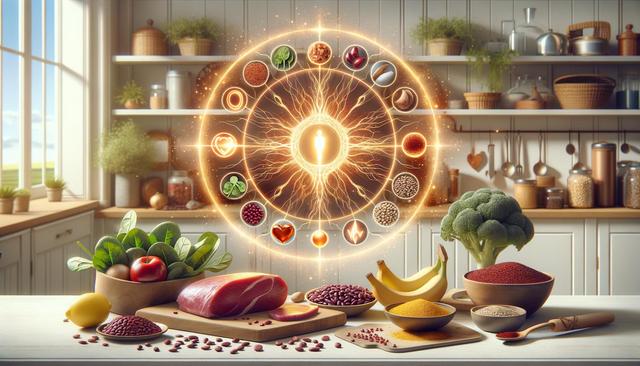Effective Tips That May Support Healthy Iron Levels
Guide To Support Healthy Iron Levels,” offers practical advice. Discover the best foods to increase iron levels naturally, like leafy greens and fortified cereals. Learn vital nutrient pairings for better absorption and ways to manage fatigue. Always consult a healthcare professional for diagnosis and personalized treatment.

Understanding the Importance of Iron
Iron is a vital mineral that plays an essential role in producing hemoglobin, a protein in red blood cells responsible for transporting oxygen throughout the body. Maintaining healthy iron levels is crucial for energy production, cognitive function, and overall well-being. Iron also supports the immune system by aiding the development of immune cells that help fight off infections. When iron levels drop too low, it can lead to iron deficiency anemia, a condition characterized by fatigue, weakness, and shortness of breath.
There are two types of dietary iron: heme iron, found in animal sources, and non-heme iron, found in plant sources. Heme iron is more easily absorbed by the body, while non-heme iron requires specific conditions to be effectively utilized. Understanding the difference between these types is the first step toward managing your iron intake and improving absorption.
Individuals at higher risk of low iron levels include menstruating women, pregnant individuals, young children, and those with gastrointestinal conditions that impair absorption. Being aware of these risk factors can help in taking preventive measures through diet and supplementation when needed.
Iron-Rich Foods to Include in Your Diet
Incorporating iron-rich foods into your daily meals is one of the most effective ways to support healthy levels. A balanced diet that includes both heme and non-heme iron sources can help maintain adequate iron stores. Here are some examples of foods that are naturally high in iron:
- Red meat, poultry, and seafood (heme iron)
- Dark leafy greens such as spinach and kale (non-heme iron)
- Legumes like lentils, chickpeas, and beans
- Iron-fortified cereals and grains
- Tofu and tempeh
- Dried fruits such as apricots and raisins
For those following vegetarian or vegan diets, focusing on plant-based iron sources and combining them with absorption-enhancing nutrients can help meet daily iron needs. Cooking in cast iron pans is another simple method that may increase iron content in food.
Boosting Iron Absorption Through Nutrient Pairings
Iron absorption is significantly influenced by the presence of other nutrients, particularly vitamin C. Pairing iron-rich foods with sources of vitamin C can enhance the bioavailability of non-heme iron. Here are some effective pairings:
- Spinach salad with oranges or strawberries
- Lentil soup with a squeeze of lemon juice
- Oatmeal topped with kiwi or berries
On the other hand, certain substances can inhibit iron absorption. These include:
- Coffee and tea (due to polyphenols)
- Calcium-rich foods and supplements
- High-fiber foods when consumed in excess
Being mindful of these interactions by timing meals and supplements appropriately can make a noticeable difference in how well your body absorbs iron from food.
Lifestyle Habits That May Influence Iron Levels
Beyond diet, several lifestyle factors can impact your body’s ability to maintain healthy iron levels. Physical activity, stress levels, and underlying health conditions all play a role. For example, endurance athletes may have increased iron needs due to higher red blood cell turnover and iron loss through sweat. Ensuring adequate iron intake and monitoring levels regularly can help support performance and recovery.
Additionally, managing digestive health is important, as certain gastrointestinal conditions like celiac disease or ulcers can impair iron absorption. Addressing these conditions through medical treatment and dietary strategies can support better nutrient uptake.
Other useful habits include:
- Regular health check-ups to monitor iron status
- Avoiding excessive use of antacids, which can lower stomach acid essential for iron absorption
- Staying hydrated to support overall metabolic function
Adopting a holistic approach that includes both dietary and lifestyle adjustments can be more effective in the long term.
When to Consider Supplements and Professional Guidance
While food should be the primary source of nutrients, iron supplements may be necessary in certain situations, such as during pregnancy, after surgery, or for individuals with diagnosed iron deficiency anemia. These supplements should always be taken under medical supervision, as excessive iron intake can lead to toxicity and other health complications.
There are various forms of iron supplements available, including ferrous sulfate, ferrous gluconate, and iron polysaccharide complexes. A healthcare provider can help determine the most suitable type and dosage based on individual needs and lab results.
It is also essential to monitor side effects, which may include constipation, nausea, or stomach discomfort. To minimize these effects, supplements can be taken with food or in smaller divided doses throughout the day. For those who experience difficulty tolerating oral supplements, intravenous iron therapy may be recommended in clinical settings.
Always consult with a healthcare provider before starting any new supplement, especially if you have underlying health conditions or are taking other medications.
Conclusion: Building a Sustainable Approach to Iron Health
Supporting healthy iron levels involves more than just adding a few iron-rich foods to your plate. It requires a combination of thoughtful dietary choices, awareness of absorption influencers, and attention to lifestyle habits. Whether you’re aiming to improve energy levels, enhance physical performance, or address specific health concerns, maintaining optimal iron levels can contribute positively to overall wellness.
By understanding the role of iron, incorporating effective food pairings, and seeking professional guidance when needed, you can take proactive steps toward sustainable iron health. Remember, each person’s nutritional needs are unique, so individualized planning and regular monitoring are key to achieving lasting results.